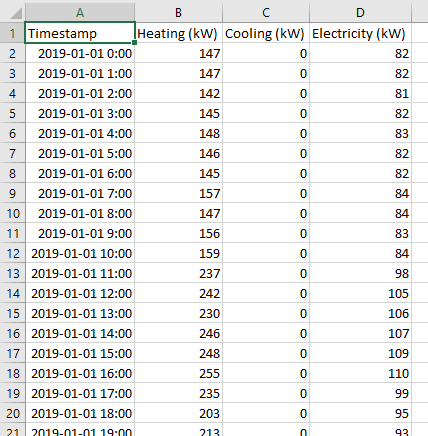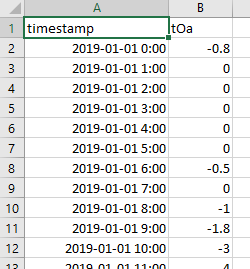Energy Baseline
The energy baseline function compares energy use during and outside scheduled air handling unit operating hours, and predicts rate of energy use at varying outdoor air temperatures.
Inputs
Energy Meter
The energy baseline function requires energy meter data. These data record the building's measured energy consumption at regular intervals. For this function, energy consumption must already be segregated into heating, cooling, and electricity consumption and must be represented in kilowatts only (kW). Electricity use should include only energy use for lighting, plug loads, distribution equipment (fans and pumps), and chillers. Cooling energy use should include only energy use for the AHUs' cooling coils. Heating energy use should include only energy use for the AHUs' heating coils, perimeter heating devices, and domestic hot water. The data file should be formatted as seen in Figure 1.

This function requires hourly energy meter data. The first column should contain the timestamp at which energy consumption is measured. The timestamp must include the numerical date and time and in the following format: [yyyy-mm-dd hh-mm]. The second column should contain the measured power consumption for heating use only. The third column should contain the measured power consumption for cooling use only. The fourth column should contain the measured power consumption for electricity use only. The column containing electricity consumption may be omitted if the building does not meet the criteria* for performing an electricity use analysis, or if the user wishes not to perform and electricity use comparison.
Only one (1) CSV file containing energy meter data for the whole building must be supplied to this function.
*Energy use comparison for electricity is valid only for buildings with on-site electricity-based cooling and without electricity-based heating.
Weather
The energy baseline function also requires outdoor weather data. These data record the outdoor air temperature within the building's geographic vicinity. The data must be formatted as seen in Figure 2.

This function requires hourly recorded outdoor weather data. The first column must contain the timestamp, which must include the numerical date and time and in the following format: [yyyy-mm-dd hh-mm]. The timestamps must be consistent with the timestamps in the energy meter data. The second column must contain the measured outdoor air temperature. For this function, measured temperatures must be represented in Celsius (oC).
Only one (1) CSV file containing weather data must be supplied to this function. Note that the timestamps must be consistent with the timestamps in the energy meter data.